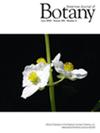Historic breeding practices contribute to germplasm divergence in leaf specialized metabolism and ecophysiology in cultivated sunflower (Helianthus annuus)
Abstract
Premise
The use of hybrid breeding systems to increase crop yields has been the cornerstone of modern agriculture and is exemplified in the breeding and improvement of cultivated sunflower (Helianthus annuus). However, it is poorly understood what effect supporting separate breeding pools in such systems, combined with continued selection for yield, may have on leaf ecophysiology and specialized metabolite variation.
Methods
We analyzed 288 lines of cultivated H. annuus to examine the genomic basis of several specialized metabolites and agronomically important traits across major heterotic groups.
Results
Heterotic group identity supports phenotypic divergences between fertility restoring and cytoplasmic male-sterility maintainer lines in leaf ecophysiology and specialized metabolism. However, the divergence is not associated with physical linkage to nuclear genes that support current hybrid breeding practices in cultivated H. annuus. Additionally, we identified four genomic regions associated with leaf ecophysiology and specialized metabolism that colocalize with previously identified QTLs for quantitative self-compatibility traits and with S-protein homolog (SPH) proteins, a recently discovered family of proteins associated with self-incompatibility and self/nonself recognition in Papaver rhoeas (common poppy) with suggested conserved downstream mechanisms among eudicots.
Conclusions
Further work is necessary to confirm the self-incompatibility mechanisms in cultivated H. annuus and their relationship to the integrative and polygenic architecture of leaf ecophysiology and specialized metabolism in cultivated sunflower. However, because self-compatibility is a derived quantitative trait in cultivated H. annuus, trait linkage to divergent phenotypic traits may have partially arisen as a potential unintended consequence of historical breeding practices and selection for yield.

 求助内容:
求助内容: 应助结果提醒方式:
应助结果提醒方式:


